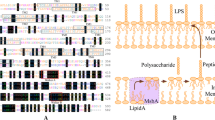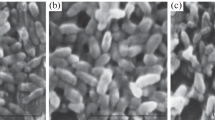Abstract
A glucose-tolerant strain of the cyanobacterium Synechocystis sp. PCC 6803, generally referred to as wild type, produces a hemolysin-like protein (HLP) located on the cell surface. To analyze the function of HLP, we constructed a mutant in which the hlp gene was disrupted. The growth rate of the mutant was reduced when the cells were stressed by treatment with CuSO4, CdCl2, ZnCl2, ampicillin, kanamycin, or sorbitol in liquid medium, suggesting that HLP may increase cellular resistance to the inhibitory effects of these compounds. Uptake assays with 109Cd2+ using the silicone–oil layer centrifugation technique revealed that both wild type and mutant cells were labeled with 109Cd2+ within 1 min. Although the total radioactivity was much higher in the wild-type cells, 109Cd2+ incorporation was clearly much higher in the mutant cells after adsorbed 109Cd2+ was removed from the cell surface by washing with EDTA. These findings suggest that HLP functions as a barrier against the adsorption of toxic compounds.


Similar content being viewed by others
References
Baumann U, Wu S, Flaherty KM, McKay DB (1993) Three-dimensional structure of the alkaline protease of Pseudomonas aeruginosa: a two-domain protein with a calcium binding parallel beta roll motif. EMBO J 12:3357–3364
Brahamsha B (1996) An abundant cell-surface polypeptide is required for swimming by the nonflagellated marine cyanobacterium Synechococcus. Proc Natl Acad Sci USA 93:6504–6509
Chojnacka K, Chojnacki A, Górecka H (2005) Biosorption of Cr3+, Cd2+ and Cu2+ ions by blue-green algae Spirulina sp.: kinetics, equilibrium and the mechanism of the process. Chemosphere 59:75–84
De Philippis R, Sili C, Paperi R, Vincenzini M (2001) Exopolysaccharide-producing cyanobacteria and their possible exploitation: a review. J Appl Phycol 13:293–299
Decho AW (1990) Microbial exopolymer secretions in ocean environments–their role(s) in food webs and marine processes. Oceanogr Marine Biol Annu Rev 28:73–153
Engelhardt H (2007) Are S-layers exoskeletons? The basic function of protein surface layers revisited. J Struct Biol 160:115–124
Flemming HC (1993) Biofilms and environmental protection. Water Sci Technol 27:1–10
Gilbert P, Das J, Foley I (1997) Biofilm susceptibility to antimicrobials. Adv Dent Res 11:160–167
Kaneko T et al (1996) Sequence analysis of the genome of the unicellular cyanobacterium Synechocystis sp. strain PCC 6803. II. Sequence determination of the entire genome and assignment of potential protein-coding regions. DNA Res 3:109–136
Liu X, Curtiss R 3rd (2009) Nickel-inducible lysis system in Synechocystis sp. PCC 6803. Proc Natl Acad Sci USA 106:21550–21554
Ludwig A (1996) Cytolytic toxins from gram-negative bacteria. Microbiologia 12:281–296
Mader C, Küpcü S, Sára M, Sleytr UB (1999) Stabilizing effect of an S-layer on liposomes towards thermal or mechanical stress. Biochim Biophys Acta 1418:106–116
McCarren J, Heuser J, Roth R, Yamada N, Martone M, Brahamsha B (2005) Inactivation of swmA results in the loss of an outer cell layer in a swimming Synechococcus strain. J Bacteriol 187:224–230
Merroun ML, Raff J, Rossberg A, Hennig C, Reich T, Selenska-Pobell S (2005) Complexation of uranium by cells and S-layer sheets of Bacillus sphaericus JG-A12. Appl Environ Microbiol 71:5532–5543
Murata N, Suzuki I (2006) Exploitation of genomic sequences in a systematic analysis to access how cyanobacteria sense environmental stress. J Exp Bot 57:235–247
Obata T, Araie H, Shiraiwa Y (2004) Bioconcentration mechanism of selenium by a coccolithophorid, Emiliania huxleyi. Plant Cell Physiol 45:1434–1441
Panoff JM, Priem B, Morvan H, Joset F (1988) Sulfated exopolysaccharides produced by two unicellular strains of cyanobacteria, Synechocystis PCC 6803 and PCC 6714. Arch Microbiol 150:558–563
Reynolds ES (1963) The use of lead citrate at high pH as an electron-opaque stain in electron microscopy. J Cell Biol 17:208–212
Sakiyama T, Ueno H, Homma H, Numata O, Kuwabara T (2006) Purification and characterization of a hemolysin-like protein, Sll1951, a nontoxic member of the RTX protein family from the cyanobacterium Synechocystis sp. strain PCC 6803. J Bacteriol 188:3535–3542
Sára M, Pum D, Sleytr UB (1992) Permeability and charge-dependent adsorption properties of the S-layer lattice from Bacillus coagulans E38–66. J Bacteriol 174:3487–3493
Schultze-Lam S, Harauz G, Beveridge TJ (1992) Participation of a cyanobacterial S-layer in fine-grain mineral formation. J Bacteriol 174:7971–7981
Silverstein A, Donatucci CF (2003) Bacterial biofilms and implantable prosthetic devices. Int J Impot Res 15:S150–S154
Singh AK, Summerfield TC, Li H, Sherman LA (2006) The heat shock response in the cyanobacterium Synechocystis sp. strain PCC 6803 and regulation of gene expression by HrcA and SigB. Arch Microbiol 186:273–286
Sleytr UB, Messner P (2000) Crystalline bacterial cell surface layers. In: Lederberg J (ed) Encyclopedia of microbiology, 2nd edn. Academic Press, San Diego, pp 899–906
Šmarda J, Šmajs D, Komrska J, Krzyžánek V (2002) S-layers on cell walls of cyanobacteria. Micron 33:257–277
Spurr AR (1969) A low-viscosity epoxy resin embedding medium for electron microscopy. J Ultrastruct Res 26:31–43
Tang JL et al (2009) Detection of metal binding sites on functional S-layer nanoarrays using single molecule force spectroscopy. J Struct Biol 168:217–222
Vaara T (1982) The outermost surface-structures in Chroococcacean cyanobacteria. Can J Microbiol 28:929–941
Wiles TJ, Kulesus RR, Mulvey MA (2008) Origins and virulence mechanisms of uropathogenic Escherichia coli. Exp Mol Pathol 85:11–19
Williams JGK (1988) Construction of specific mutations in photosystem II photosynthetic reaction center by genetic-engineering methods in Synechocystis 6803. Methods Enzymol 167:766–778
Yubuki N, Inagaki Y, Nakayama T, Inouye I (2007) Ultrastructure and ribosomal RNA phylogeny of the free-living heterotrophic flagellate Dysnectes brevis n. gen., n. sp., a new member of the Fornicata. J Eukaryot Microbiol 54:191–200
Acknowledgments
We thank Dr. T. Kuwabara for his critical discussion and advice, and Dr. T. Hama and Miss M. Sawai for operation of the flow cytometer, all of whom are at the University of Tsukuba (UT). The radiolabeling experiments were performed in the Radioisotope Center of UT with their kind help, especially in the 109Cd uptake experiments.
Author information
Authors and Affiliations
Corresponding author
Additional information
Communicated by ErkoStackebrandt.
Electronic supplementary material
Below is the link to the electronic supplementary material.
Rights and permissions
About this article
Cite this article
Sakiyama, T., Araie, H., Suzuki, I. et al. Functions of a hemolysin-like protein in the cyanobacterium Synechocystis sp. PCC 6803. Arch Microbiol 193, 565–571 (2011). https://doi.org/10.1007/s00203-011-0700-2
Received:
Accepted:
Published:
Issue Date:
DOI: https://doi.org/10.1007/s00203-011-0700-2




